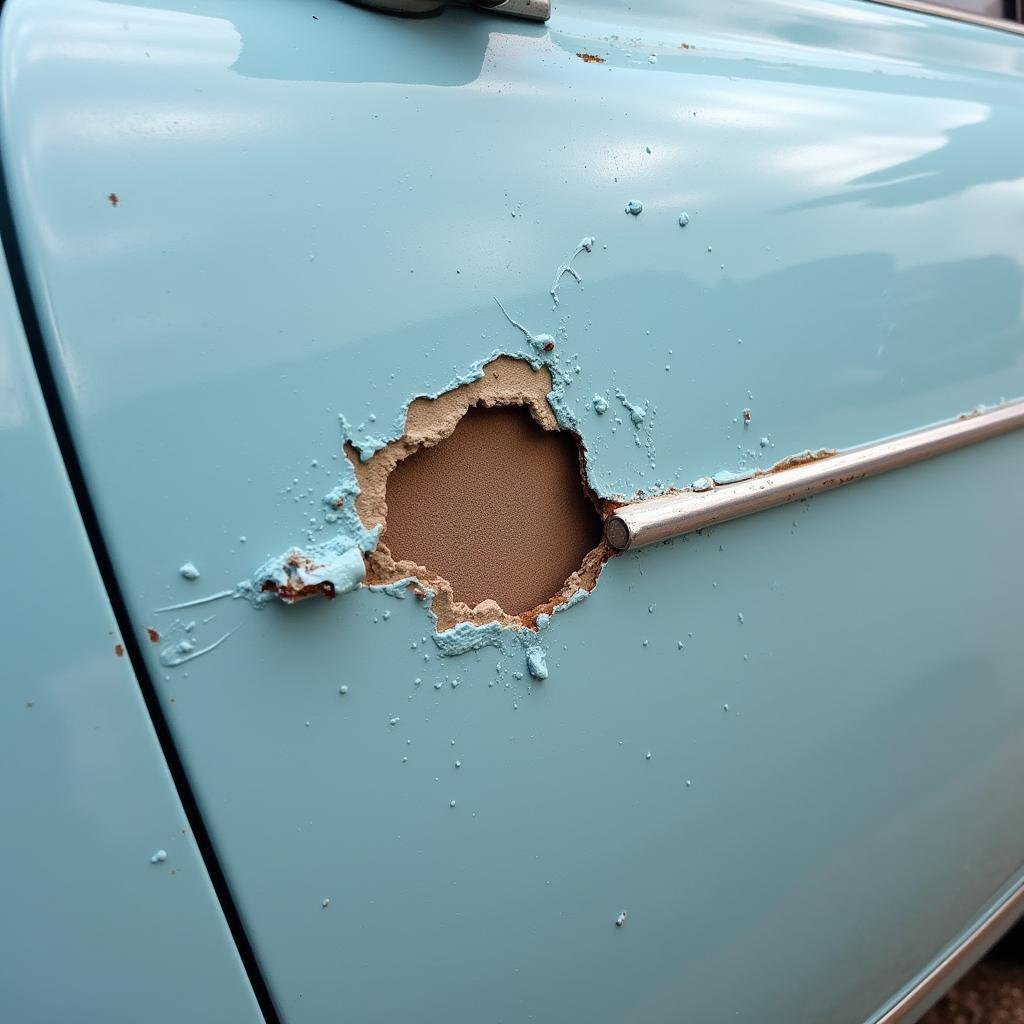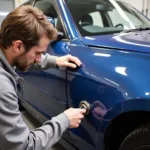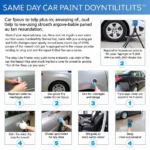Car paint chipping after a repair can be incredibly frustrating. You expect a flawless finish, not peeling or flaking paint. This article dives into the common causes of this issue and provides solutions to prevent and fix car paint chipping after repair, helping you restore your car’s pristine appearance. Let’s explore why this happens and how to avoid it.
A fresh paint job should last for years, so why does it sometimes start chipping soon after a repair? Several factors can contribute to this problem, ranging from improper preparation to environmental factors. Understanding these causes is crucial to achieving a durable and beautiful finish. More information on general car painting can be found at car painting repair.
Common Causes of Car Paint Chipping After Repair
Improper Surface Preparation
One of the most common culprits is inadequate surface preparation. If the original surface wasn’t properly cleaned and prepped before the new paint was applied, adhesion issues can arise. Dirt, grease, rust, and old paint can prevent the new paint from bonding correctly, leading to chipping.
Low-Quality Paint or Clear Coat
Using low-quality paint or clear coat can also contribute to chipping. These products may not be as durable and resistant to environmental factors like UV rays and temperature changes, making them more susceptible to damage.
Incorrect Application Techniques
Incorrect application techniques, such as applying the paint too thickly or thinly, or not allowing sufficient drying time between coats, can also weaken the paint’s integrity and make it prone to chipping.
Environmental Factors
Environmental factors, such as exposure to harsh weather conditions, road debris, and even car washes, can chip the paint. Extreme temperatures, especially rapid fluctuations, can cause the paint to expand and contract, leading to stress fractures and chipping. Check out more information if your paint came.off.after car repair.
Impact Damage
Impact damage from rocks, gravel, and other road debris is a common cause of paint chips, especially on the front of the vehicle.
Preventing Car Paint Chipping After Repair
Thorough Surface Preparation
Thorough surface preparation is crucial. This involves cleaning the area to be painted with a degreaser, removing any rust, sanding the surface smooth, and applying a primer to promote adhesion.
High-Quality Paint and Clear Coat
Investing in high-quality paint and clear coat is essential for a long-lasting finish. These products are formulated to be more durable and resistant to environmental factors. Here’s a helpful guide on how to repair chipped chrome paint on exterior of car.
Proper Application Techniques
Ensuring proper application techniques, including applying thin, even coats and allowing sufficient drying time between coats, is vital for a strong and chip-resistant finish.
Paint Protection Film (PPF)
Consider applying a paint protection film (PPF) to vulnerable areas, such as the front bumper and hood. PPF provides a transparent barrier against rock chips and other minor impacts.
Repairing Car Paint Chips
Small paint chips can often be repaired using touch-up paint. Larger chips or areas of peeling paint may require professional repair. Sometimes even a car wash pressure hose peeled off paint on car repair. For more localized repairs, check out resources on car paint chip repair swindon.
DIY Touch-Up Paint
For minor chips, carefully clean the area, apply the touch-up paint in thin layers, and allow it to dry completely. Sanding and polishing may be necessary to blend the repair with the surrounding paint.
Professional Repair
For more extensive damage, professional repair is recommended. A professional can properly assess the damage, prepare the surface, and apply the paint for a seamless and durable finish.
“Proper surface preparation is paramount,” says renowned auto body specialist, John Miller. “It’s the foundation for a long-lasting, chip-resistant paint job. Skimping on this step is a recipe for disaster.”
Conclusion
Car paint chipping after repair can be avoided by focusing on proper surface preparation, using high-quality materials, and ensuring correct application techniques. By understanding the causes and taking preventative measures, you can keep your car looking its best for years to come. Remember, a flawless paint job starts with a solid foundation.
FAQ
- Why is my car paint chipping after a recent repair? Likely due to improper surface preparation, low-quality paint, incorrect application, or environmental factors.
- How can I prevent car paint from chipping? Thorough surface preparation, high-quality paint, proper application, and PPF can help prevent chipping.
- Can I repair car paint chips myself? Minor chips can be repaired with touch-up paint, but larger chips may require professional repair.
- What is the best way to prepare the surface for painting? Clean thoroughly, remove rust, sand smooth, and apply a primer.
- How long should I wait between coats of paint? Follow the manufacturer’s instructions for drying times between coats.
- What is PPF? Paint Protection Film (PPF) is a transparent film that protects against rock chips and minor impacts.
- When should I seek professional repair for car paint chips? For larger chips, peeling paint, or if you’re unsure about DIY repair.
“Investing in high-quality paint and a skilled professional is worth it in the long run,” adds Sarah Chen, an experienced automotive painter. “It’s an investment in the overall appearance and value of your vehicle.”
For further reading, explore articles on related topics like car detailing and paint maintenance on our website. You can also find more information on specific car models and repair techniques.
Need help with car paint chipping after repair? Contact us via WhatsApp: +1(641)206-8880 or Email: [email protected]. Our 24/7 customer service team is here to assist you.



